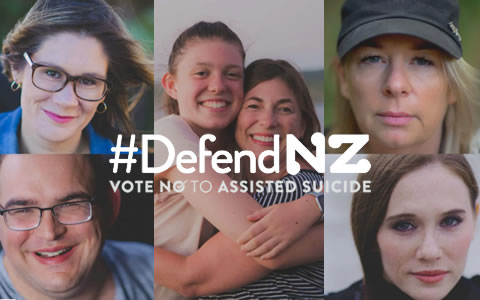A new movement targets a bill being honed to maximise support
By Carolyn Moynihan, Deputy Editor, MERCATORNET
New Zealand groups opposing euthanasia have come together in a movement to fight legislation in parliament that could soon legalise assisted suicide. #DefendNZ launched on March 10 with a website and video trailer introducing Kiwis who could be eligible for assisted suicide under a bill that could be passed in the current parliamentary session.
Not satisfied with our mounting suicide rate – at a 10-year high in the year to June 2018 – the right-to-die lobby want to encourage the terminally ill and seriously disabled to think along those lines. It’s only about “the right to choose,” they say, but that is not how many of those living with disabilities and illness see it.
Over the next few weeks #DefendNZ will feature some of them in five mini-documentaries exploring the impact the End of Life Choice Bill would have on their relationships with their doctors and caregivers, on how society views and values their lives, on the way they feel about themselves, and on their safety. Former MP, Hon. Dame Tariana Turia DNZM will also share her perspectives in these documentaries.
The bill is a project of Act Party MP David Seymour. Mr Seymour, the sole representative of his party in parliament, is a libertarian who has taken up the cause of right-to-die advocates The cause received a major boost from the 2015 case of Lecretia Seales, a lawyer with terminal brain cancer who appealed to the High Court claiming a right to assisted suicide under the New Zealand Bill of Rights Act.
The Court’s finding, that there was no such right in the law, led to a petition to parliament to change the law, and a commission of inquiry attracting over 21,000 submissions – 80 percent of which were opposed to any form of euthanasia.
Another public consultation on Seymour’s bill brought a record 37,000 submissions last year and a large number of people wanting to be heard in person. The Justice Select Committee is due to report back to parliament by the end of this month. A huge majority of submitters – 92 percent — again oppose the bill.
Of particular concern is a clause permitting assisted suicide for a person with “terminal illness or grievous and irremediable condition.” A “grievous and irremediable condition” is defined as “degenerative, unable to be successfully treated, and very severe,” which has raised fears among people with disabilities about how their lives may be viewed in future.
In response, Seymour has proposed eliminating this provision from his bill, to the dismay of the euthanasia lobby. However, it will help keep the Greens, who are concerned about voters suffering disabilty, on board. Other changes include eliminating advance directives.
He has also “made explicit” that mental health conditions and disability alone do not allow a person to have a doctor kill them. To get the support of the New Zealand First MPs he says the issue should be the subject of a binding referendum at the next election.
The country has a proud record of ignoring referenda results, but to keep its coalition partner NZ First happy, Labour might go along with this one. It has already committed itself to a binding referendum on personal cannabis use at the 2020 election.
Seymour also proposes incorporating an Access to Palliative Care Bill sponsored by National MP Maggie Barry, and an amendment to protect the conscience rights of pharmacists, nurses and medical practitioners.
With these changes he hopes to get enough support in parliament – and, with any luck, the voting populace — to get the principle of a right to assisted suicide enshrined in law – after several failed attempts over the last few decades.
Whether that would do anything for the government’s promised wellbeing budget outcomes remains to be seen.
This article by Carolyn Moynihan was originally published on MercatorNet under a Creative Commons licence. The original article can be found here.











0 Comments